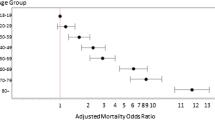Abstract
Cross-sectional economic models of traffic fatalities are estimated to determine the effectiveness of state statutes that require motor vehicle occupants to use seat belts. The estimates provide some support for the theory of offsetting consumer behavior. In the case of primary enforcement front-seat belt laws, models suggest that rear-seat passengers and nonoccupants may be killed as a result of more dangerous driving by belted drivers. In the case of secondary enforcement front-seat belt laws, there is no favorable or unfavorable effect that is statistically significant. Models that employ self-reported seat belt usage rates from the Centers for Disease Control suggest an offsetting effect for rear-seat passengers and non-occupants as in the case of the models for primary seat belt laws.Footnote 1
Similar content being viewed by others
Notes
Early results of this work were reported at the Southern Economic Association Meetings, November 1990, New Orleans. Partial funding for this project was provided by a grant from the Kellogg Foundation to the Missouri Youth Initiative Program.
References
Campbell, B.J. and Cambell, F.A. (1988). Injury reduction and belt use associated with occupant restraint laws, in: J.D. Graham (ed.),Preventing automobile injury: New findings from evaluation research. Dover: Auburn House Publishing Company.
Centers for Disease Control (1988). Comparison of observed and self-reported seat belt use rates - United States,Morbidity and Mortality Weekly Report 36: 549–551.
Crandall, R.D., Guenspecht, H.K., Keler, T.E. and Lave, L.B. (1986).Regulating the automobile. Washington, DC: The Brookings Institution.
Evans, W.N. and Graham, J.D. (1991). Risk reduction or risk compensation? The case of mandatory safety belt use laws,Journal of Risk and Uncertainty 4: 61–73.
Federal Highway Administration (1987).Highway statistics.
Garbacz, C. (1990a). How effective is automobile safety legislation?,Applied Economics 22: 1705–1714.
Garbacz, C. (1990b). Estimating seat belt effectiveness with seat belt usage data from the Centers for Disease Control,Economics Letters 34: 83–88.
Garbacz, C. (1991). Impact of the New Zealand seat belt law,Economic Inquiry 29: 310–316.
Garbacz, C. (1992). More evidence on the effectiveness of seat belt laws,Applied Economics 24: 313–315.
Graham, J.D. (1983). Automobile safety: An investigation of occupant protection policies. Ph.D. dissertation, Carnegie-Mellon University.
Lave, C. (1989). Speeding, coordination and the 55 mph limit: Reply,American Economic Review 79: 926–931.
Lave, L.B. and Weber, W.E. (1970). A benefit-cost analysis of auto safety features,Applied Economics 4: 265–275.
MacAvoy, P.W. (1976). Comment, in: H.G. Manne and R.L. Miller (eds.),Auto safety regulation: The cure or the problem? Glen Ridge, NJ: Thomas Horton.
McKenzie, R.B. and Tullock, G. (1989).The best of the new world of economics...and then some, 5th ed. Homewood: Irwin.
National Safety Council (1990).Accident facts. Chicago, Illinois.
Peltzman, S. (1975). The effects of automobile safety regulations,Journal of Political Economy 83: 677–726.
Reinfurt, D.W., Campbell, B.J., Stewart, J.R. and Stutts, J.C. (1987). North Carolina's occupant restraint law: A three year evaluation. Chapel Hill, NC: Highway Safety Research Center, University of North Carolina, No. HSRC-PR158.
Sass, T.R. and Leigh, J.P. (1991). The market for safety regulation on fatalities: The case of motorcycle helmet laws,Review of Economics and Statistics 73: 167–172.
Zlatoper, T.J. (1991). Determinants of motor vehicle deaths in the USA: A cross-sectional analysis,Accident Analysis and Prevention 23: 431–436.
Author information
Authors and Affiliations
Rights and permissions
About this article
Cite this article
Garbacz, C. Do front-seat belt laws put rear-seat passengers at risk?. Popul Res Policy Rev 11, 157–168 (1992). https://doi.org/10.1007/BF00125536
Issue Date:
DOI: https://doi.org/10.1007/BF00125536




